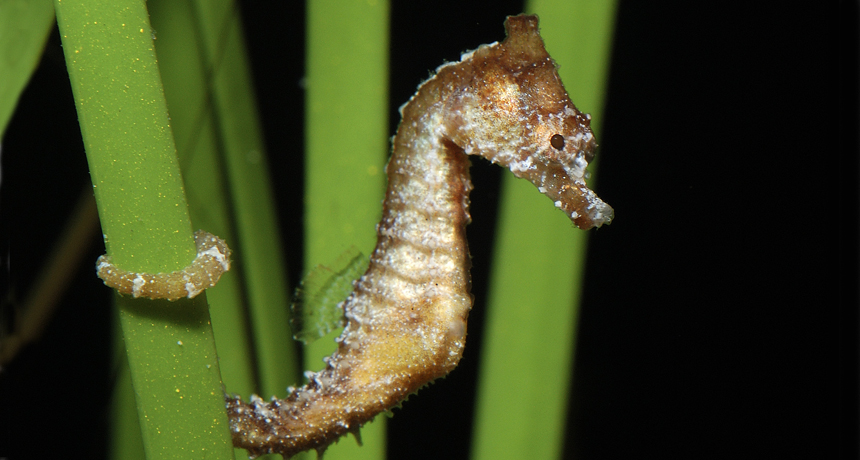How seahorses use their heads
The odd shape of a dwarf seahorse’s head lets it sneak up and snack on unsuspecting prey

The dwarf seahorse is a slow but stealthy swimmer. A new study shows how the shape of the fish’s head helps it sneak up on prey.
GREGORY G. DIMIJIAN/SCIENCE SOURCE
Dwarf seahorses swim slowly. That doesn’t seem to hurt their ability to catch prey, however. What they lack in speed they make up for in stealth. Their jaws approach their prey, undetected, until they’re closer than the thickness of a penny. Then the fish strike before their snack can escape. Scientists recently reported they’ve found the secret to this seahorse’s sneak attack: the unusual shape of its head.
Seahorses often eat copepods, tiny shrimplike crustaceans that share the same watery neighborhoods as the fish. But copepods will swim away quickly when they sense a predator nearby. They need only two or three milliseconds of warning, says Brad Gemmell. He’s a marine biologist at the University of Texas at Austin. That amount of time is about as long as it takes a fly to flap its wings.
A dwarf seahorse (Hippocampus zosterae) can strike in less than half that time. But to succeed, the fish has to practically swim right up to the copepod without scaring it away. That’s where the head trick comes in, says Gemmell. He and his coworkers found that as a seahorse swims, a small zone of water in front of its head barely moves. And that calm water is key, they reported November 26 in Nature Communications.
Copepods use antenna hairs to sense danger, like the whoosh of water that precedes an attacking predator. But because of the shape of its head, a dwarf seahorse won’t stir up the water. So the copepods never know what’s coming.
Gemmell notes that dwarf seahorses are some of the slowest-swimming fish in the sea. And because their snouts are shorter than that of other seahorses, they must strike from a closer distance. But thanks to their head shape, they can still catch “one of the most capable escape artists on the planet,” he told Science News.
Dwarf seahorses and some copepods inhabit underwater meadows of sea grass in the Gulf of Mexico and other parts of the Caribbean. The meadow’s slow water flow makes nearby movements —like a watery whoosh — easier for copepods to detect. But dwarf seahorses use their heads to sneak around.
This could be a running contest between prey and attacker. The copepods evolve, or develop over a long period of time, better escapes. Then seahorses evolve better stealth, explains Sam Van Wassenbergh. A biologist at Ghent University in Belgium, he did not work on the new study.
To investigate the seahorse’s secret, Gemmell and his coworkers shined lasers through water in a tank containing dwarf seahorses and copepods. Particles suspended in the water bumped the laser light and caused tiny changes in its direction. By studying these changes, the scientists could tell how the fluid moved. When they studied the laser’s path around the head of attacking seahorses, the scientists observed a little spot near the top of the snout where the water stayed calm.
Getting close is key, Gemmell says. Other fish other succeed at catching copepods in calm water about 33 percent of the time. But when a dwarf seahorse gets within striking range, he notes that it will catch a copepod an impressive 94 percent of the time.
Power Words
copepod A large class of small crustaceans found in the ocean and in freshwater habitats.
crustaceans Hard-shelled, water-dwelling animals including lobsters, crabs and shrimp.
evolve To change gradually over generations, or a long period of time. In living organisms, the evolution usually involves random changes to genes that will then be passed along to an individual’s offspring. These can lead to new traits, such as altered coloration, new susceptibility to disease or protection from it, or different shaped features (such as legs, antennae, toes or internal organs).
millisecond One-thousandth of a second
predator (adjective: predatory) A creature that preys on other animals for most or all of its food.
prey Animal species eaten by others.







